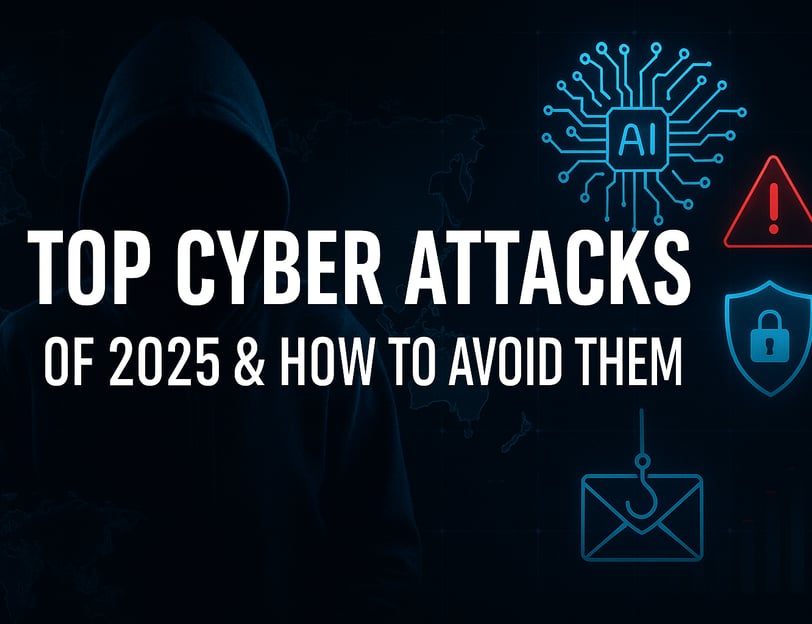Top Five Scam Of 2025 & How to Aviod Them
Let’s dive in to the top cyber attacks of 2025 and how to protect yourself before it’s too late. From AI-generated phishing scams to global ransomware threats and smart device breaches, this blog breaks down the most dangerous cybercrimes happening around the world right now. Perfect for everyday readers, we explain each threat in simple terms and give you real, practical steps to stay safe online.
TECH NEWS & UPDATES


Cyber scams are most common these days; hence, they have rapidly grown over the past five years. In 2020–2021, the estimated cyber growth rate in the world was 17%, but now, in 2024–2025, it is rapidly growing and is estimated around 38%–40%. This rapid growth is quite alarming, as more and more people will fall for the scam, and the number will rise. To make the numbers drop, we don’t actually need the help of local police or government we, as common people, can do it by not falling for these scams. I have made around five top cyberattacks currently running around the world, so let’s dive in with threats and preventions.
1. AI-Powered Phishing and Social Engineering
Threat: Phishing scam with the help of AI that can easily mimic your co-worker's writing style or even create a sound like a deepfake that sounds exactly like your friend or your family member. As the new tech is helping others, sadly, it is also helping scammers. It was also used by scammers to scam more accurately. For example, you may get a call from your daughter with her voice pleading for help. This is a common trick nowadays, as these scammers are using deepfake AI cloning tools that help them get the voice they like. These voices are so real that you don’t think that you have been tricked.
Prevention: Be cautious with any unexpected request, no matter what the channel used by scammers—either message, email, call, or even a video claiming that your loved one is not safe and needs your money. Don’t panic; instead, take a deep breath. You can call them on their actual number to confirm whether or not they are in trouble. For emails, see if the sender email address is authentic, read carefully, and then check the content, like greetings, typos, and strange links. Use a two-factor authentication code for your socials like Facebook, Google account, etc., so if a scammer wants access, the password comes to you.
This scam is common in the USA, the UK, and India.
2. Ransomware-as-a-Service (RaaS)
Threats: Ransomware is software that encrypts your device. In simple terms, it can hijack your device and then demand money to remove this software from your devices, but now, in 2025, it can be rented as a service model, just like you are renting an apartment. These scammers can rent this software without much technical knowledge needed. This means that a non-technical person can get the software on a rental and attack people, businesses, and local governments, and try to demand big. These tools are becoming so sophisticated, even using AI in some cases, that hackers have found a way to launch an attack without much expertise needed.
Prevention: To avoid being scammed by these people, avoid opening links from unknown emails or clicking random links. Many of these ransomware attacks started with someone clicking on these links or downloading malicious files. To avoid all of these, make sure you are updating your device regularly, backing up your important data, and trying to install on a different storage device or on a cloud service. If you face the attack, you don’t have to pay those scammers, as your files are secured. Use reputable antivirus or antimalware systems that can help you to catch known ransomware. If you are hit by these scammers, the best way is to not pay them a single dime, as there is no guarantee that you can restore your files after paying them. Instead, focus on the backup and report to your local authorities.
It is common in Australia, the USA, and Germany
3. Credential Stuffing & Password Attacks
Threats: Every time a website has been hacked or suffers a breach, the usernames and passwords with emails often leak in an attack, and a hacker can use these passwords to try to log in to your different accounts and surprisingly succeed because a recent study says that 94% use the same password for other websites and only 6% use different passwords for different websites. These repeated passwords are not gold but diamonds for scammers, as they can hack your socials and bank accounts with your email and passwords.
Prevention: Use secure and long-tail passwords. I would recommend you use SecurePass Generator to recommend long-tail passwords for all your social apps, and you can save them on your mobile notes for later use. In addition to that, you can use 2FA for apps and websites that support it, as attackers still need a One-time password to access login. Check sites that tell you if your accounts have been breached or compromised services, like haveibeenpwned.com can help you in this case.
The scam has happened in the USA, Canada, Brazil, and France.
4. Supply Chain Attacks (Software & Third-Party Attacks)
Threats: A supply chain attack targets those software or services that you trust. They directly attack companies that are providing the services or making apps, and then when you install or update, the hidden malware comes to attack you and thousands more people who download the files or update some apps. These tactics are booming among these scammers, as recently Mark & Spencer in the UK was attacked by these groups for a period of three weeks, which affected contactless payments and click-and-collect services. Personal data was compromised, but thank God financial records were saved.
Prevention: For individuals, download from official sites and known websites and update. Never update or download something that seems off or from unknown websites. Ensure that the updates don’t include any malware (check for digital signatures to ensure software hasn’t been compromised yet), pay attention to or follow these types of news that tell you about these possible attacks on sites, and lastly, use a good antimalware system to check alarming situations before downloading.
5. Data Breaches From Smart Home Devices
Threat: In today’s homes, there are smart appliances used from fridges to speakers, TVs, and cameras. These devices collect data and can be hacked; this is also known as the Internet of Things (IoT). This IoT has a weak flow, meaning if your camera or speaker has outdated software or a default password, an attacker can break into it and steal the data on it, like videos or voice recordings, or they can even control your whole system.
Prevention: Secure your every smart device with strong passwords and remove the default password from it. Use strong and unique passwords that are not easy to break. For this, I will again recommend you use SecurePass Generator. You can easily create strong passwords and store them manually in your smartphone or write them down on paper. Make sure you are updating your device regularly to have security features updated on the device. Disable features that you don’t use regularly, like your speaker microphone or your TV’s home access location. Buy devices from reputable brands that support security updates.
In 2025, as expected, they are using new technology to trick innocent people and make the scam believable. Use basic digital practices of making strong passwords and using 2FA, which is very important nowadays. Don’t click any links that you don’t trust, and most importantly, don’t share your 2FA (two-factor authentication) one-time password code with anyone, no matter what the circumstance is. Lastly, be informed about the latest scams that are trending in the market, and make sure to enjoy today’s technology without falling for them.
